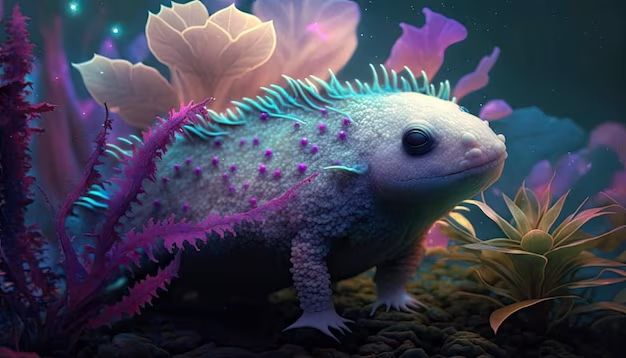Quick Answer
Lizards can rarely be purple in the wild, as purple is an uncommon color in nature. There are a few species of lizards that can have hints of purple, violet, or lavender coloration due to structural coloration, pigmentation, or diet. But a truly bright or deep purple lizard is very uncommon. Through selective breeding or genetic modification, it may be possible to create vibrantly purple lizards.
What Colors Can Lizards Be?
Lizards can come in a huge variety of colors. Some of the most common lizard colors include:
– Brown
– Green
– Gray
– Red
– Yellow
– Orange
– White
– Black
These colors provide camouflage in the lizards’ natural habitats. Brightly colored skin or scales can also serve as a warning to predators that the lizard may be venomous or toxic.
Some lizards also display brighter blue, turquoise, pink, or purple tones. These are less common in the wild, but can occur naturally due to:
– Structural coloration – Microscopic structures in the skin or scales reflect specific wavelengths of light. This can create vivid blues, violets, and greens.
– Pigmentation – Special pigment cells produce non-brown and non-green pigments. Reds, oranges, yellows, blues, and purples are possible.
– Diet – Pigments from certain foods can be deposited in the skin or scales. For example, carotenoids from plants and fruits can produce yellows, oranges, and reds.
So while bright purple lizards are very rare, some species can display lighter lavender, lilac, violet, or purple-gray tones.
Lizard Species with Hints of Purple
Here are a few lizard species that can occasionally display purplish coloration:
– Jackson’s Chameleon – These African chameleons are famous for their color changing abilities. While they are usually green, they can turn shades of blue, orange, black, brown, light pink, and purple when stressed or defending their territory.
– Panther Chameleon – Native to Madagascar, panther chameleons also change colors. Males in particular can display spectacular blues, pinks, oranges, greens…and occasional purples.
– Bearded Dragon – The common pet lizard can sometimes have a lavender or pale violet coloration, especially on their throats or when they are young.
– Blue Spiny Lizard – These lizards found in Mexico and the Southwestern US often have black, gray, olive, or brown base colors. But they can also display turquoise, purple, orange, and yellow tones on their scales.
– Purple-Colored Day Gecko – There are over 100 species of day geckos. Phelsuma klemmeri, found on the Seychelles Islands off East Africa, can have a bright purple body and yellow spots.
– Emerald Tree Skink – Skinks are lizards in the family Scincidae. The emerald tree skink from New Guinea has a dark purple tongue and can sometimes display muted purple skin.
So in their natural habitats, vibrant purple lizards are exceptionally rare. But brighter lavenders, violets, lilacs, and magentas can occasionally occur.
Creating Bright Purple Lizards
While wild lizards with deep purple coloration are unlikely, could vibrantly purple lizards be created through selective breeding or genetic modification?
Selective Breeding
Selective breeding involves mating individuals with desired traits over multiple generations to eventually produce offspring with exaggerated versions of those traits.
Many domesticated plants and animals were created through selective breeding. For example, breeding green-colored budgies over generations led to vibrant sky blue and violet budgies.
Breeders might be able to select for purple color mutations in reptiles like leopard geckos, crested geckos, or gargoyle geckos. Across many generations, richer purples could potentially be stabilized.
Genetic Modification
Directly modifying genes related to coloration could more quickly produce brightly purple lizards compared to selective breeding.
In 2010, researchers at National University of Singapore used fluorescence proteins from jellyfish DNA to genetically engineer fluorescent red, green, and orange bearded dragons.
Similar fluorescent protein genes could potentially be inserted to make lizards that glow deep purple under UV light. Or other color-related genes could be modified.
However, there are challenges and ethical concerns with genetically modifying reptiles solely for aesthetic purposes. More research would be needed to safely develop vibrantly purple genetically engineered lizards.
Occasional Purple Lizards in Myth and Culture
While truly bright purple lizards are extremely rare in nature, they have occasionally appeared in myth, culture, and folklore over the centuries:
– In Australian Aboriginal folklore, an ancestral figure named Mangar-kunjer-kunja was said to have skin that was bright purple in color. He was associated with the creation of the Milky Way galaxy.
– Some tales from Central America described the Minhocão, a giant purple underwater lizard or serpent-like creature.
– In the epic Sanskrit poem the Ramayana, a purple lizard figure tries to destroy a fortified city before being killed by Rama.
– Local legends in India tell of rare purple lizards called Balpam that possess special powers and posion.
– In the Middle Ages, some European bestiaries (companion books about animals) claimed lizards could change colors, including turning vibrant purple.
So while scientifically implausible, the idea of bright purple lizards has resonated through human culture for centuries.
Conclusion
Vibrantly purple lizards are extremely uncommon in the wild due to the rarity of that coloration providing an evolutionary advantage. But a small number of lizard species can display lighter purples, lavenders, violets, and lilacs naturally. Through selective breeding or genetic engineering, it may someday be possible to create deeper purple-colored lizards. For now, truly bright purple lizards are confined to the realms of myth and imagination. But perhaps in the future, vivid purple lizards could become a reality through continuing advances in genetics and synthetic biology.


